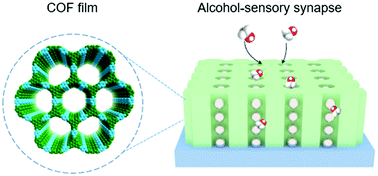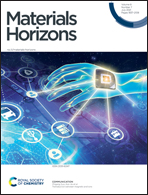2D oriented covalent organic frameworks for alcohol-sensory synapses†
Abstract
Resistive random access memories (RRAMs) based on the electrochemical metallization mechanism (ECM) have potential applications in high-density data storage and efficient neuromorphic computing. However, the high variability of ECM devices still hinders their application in artificial intelligence owing to the random formation of conductive filaments (CFs). Here, we demonstrate 2D covalent organic framework (COF) RRAM with electroforming-free resistive switching behavior, low spatial/temporal variations, and excellent retention capability up to 105 s. The one-dimensional channels of the oriented COF-5 film can not only confine the shape of filaments but also modulate the transition direction of Ag ions. Moreover, alcohol vapors could activate the device to achieve gas-mediated multilevel resistive switching since COF materials can absorb small molecules through host guest interactions to vary the conductivity. An alcohol gas recognition system constructed by integrating the COF RRAM as a sensor and filter part with the k-nearest neighbors (KNN) algorithm as a classifier was demonstrated with a recognition accuracy of 87.2%. Furthermore, the effect of alcohol inhibition stimulation in the human nervous system is successfully emulated by the COF RRAM.



 Please wait while we load your content...
Please wait while we load your content...